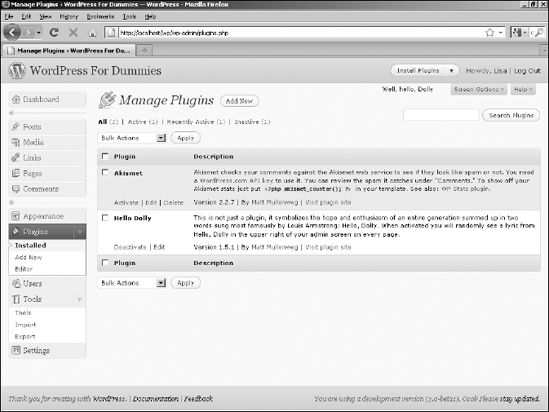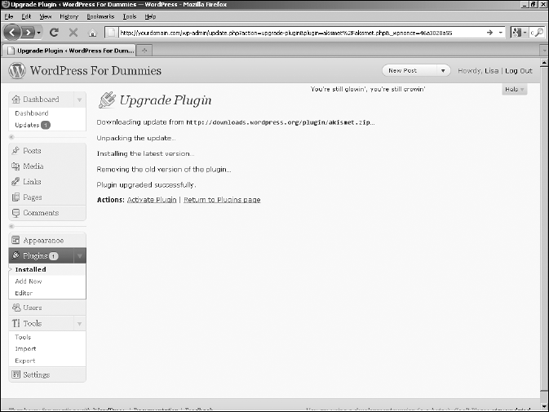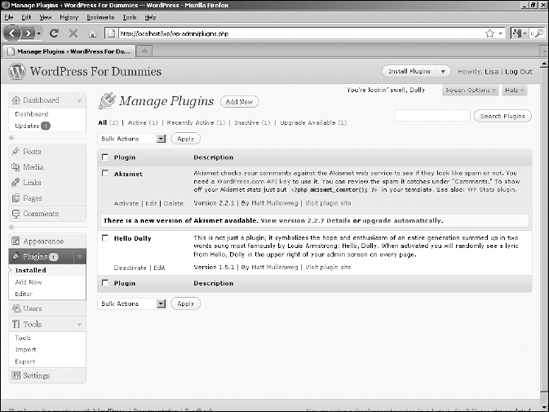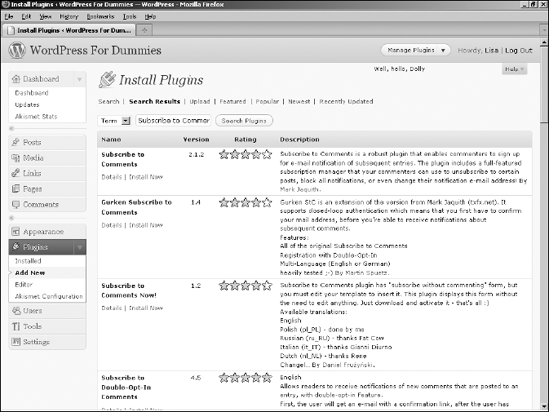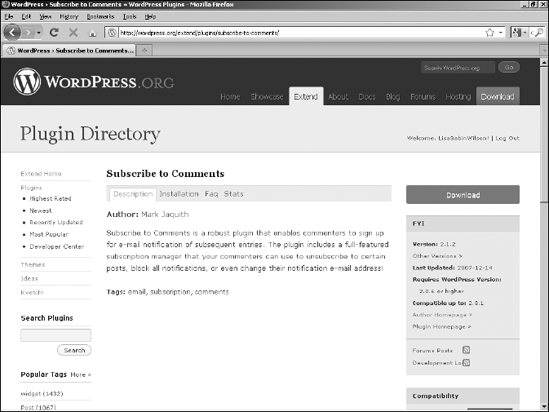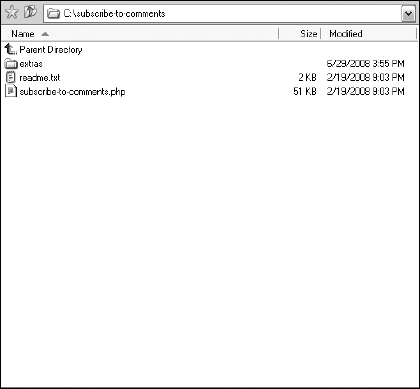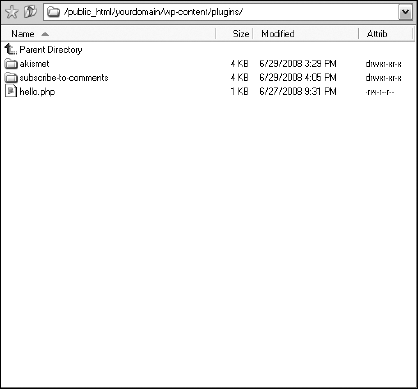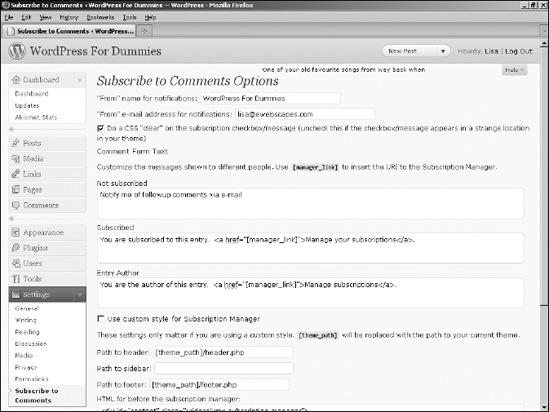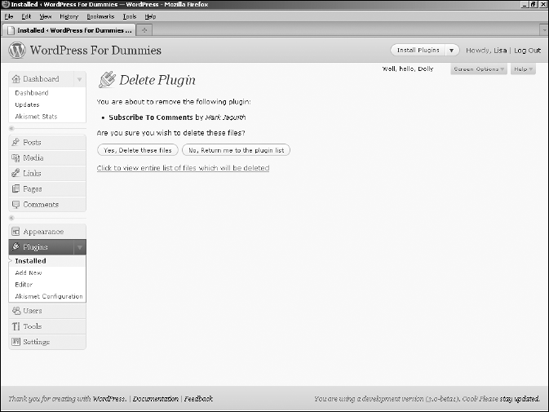In This Chapter
Plugging in to plugins
Finding, downloading, and unpacking plugin files
Uploading and installing plugins
Activating and managing plugins
Using the plugins that come with WordPress
Exploring open source plugins
Half the fun of running a WordPress–powered blog is playing with the hundreds of plugins that you can install to extend your blog's functions and options. WordPress plugins are like those really cool custom rims you put on your car: Although they don't come with the car, they're awesome accessories that make your car better than all the rest.
In this chapter, you find out what plugins are, how to find and install them, and how they enhance your blog in a way that makes your blog unique. Using plugins can also greatly improve your readers' experiences by providing them various tools they can use to interact and participate — just the way you want them to!
This chapter assumes that you already have WordPress installed on your Web server. Installing plugins pertains only to the WordPress.org software. If you're skipping around in the book and haven't yet installed WordPress on your Web server, you can find instructions in Chapter 6.
Note
WordPress.com users can't install or configure plugins on their hosted blogs. I don't make the rules, so please don't kill the messenger.
A plugin is a small program that, when added to WordPress, interacts with the software to provide some extensibility to the software. Plugins aren't part of the core software; they aren't software programs either. They typically don't function as stand-alone software. They do require the host program (WordPress, in this case) to function.
Plugin developers are the people who write these gems and share them with the rest of us — usually, for free. Like WordPress, plugins are free to anyone who wants to further tailor and customize his site to his own needs.
Although plugins are written and developed by people who have the set of skills required to do so, I would say that the WordPress user community is also largely responsible for the ongoing development of plugins. Ultimately, the end users are the ones who put those plugins to the true test of the real world in their own blogs. Those same users are also the first to speak up and let the developers know when something isn't working right, helping the developers troubleshoot and fine-tune their plugins. The most popular plugins are created by developers who encourage open communication with the user base. Overall, WordPress is one of those great open source projects in which the relationship between developers and users fosters a creative environment that keeps the project fresh and exciting every step of the way.
Literally thousands of plugins are available for WordPress — certainly way too many for me to list in this chapter alone. I could, but then you'd need heavy machinery to lift this book off the shelf! So here are just a few examples of things that plugins let you add to your WordPress blog:
E-mail notification: Your biggest fans can sign up to have an e-mail notification sent to them every time you update your blog.
Submit your blog to social networking services: Allow your readers to submit your blog posts to some of the most popular social networking services, such as Digg, Technorati, and Del.icio.us.
Stats program: Keep track of where your traffic is coming from; which posts on your blog are the most popular; and how much traffic is coming through your blog on a daily, monthly, and yearly basis.
Chapter 17 gives you a peek at some of the most popular plugins on the scene today. In the meantime, this chapter takes you through the process of finding plugins, installing them in your WordPress blog, and managing and troubleshooting them.
Before you start installing plugins for your blog, it's important for you to explore the Manage Plugins page in your WordPress Dashboard and understand how to manage the plugins after you install them. Click the title of the Plugins menu on your WordPress Dashboard to view the Manage Plugins page (shown in Figure 10-1).
The Manage Plugins page is where you manage all the plugins you install in your WordPress blog. By default, the Manage Plugins page displays a full listing of all the WordPress plugins you currently have installed. You can filter the listing of plugins using the three links shown directly below the Manage Plugins page title:
All: This is the default view for the Manage Plugins page and shows a listing of all plugins currently installed on your WordPress Web site, whether they are active or not.
Active: Clicking this link shows a list of the plugins that are currently activated and in use on your WordPress Web site.
Inactive: Clicking this link changes the display and shows list of plugins that are installed but not currently active. (Note: This link only displays on the Manage Plugins page if you have inactive plugins.)
With a quick glance at the Manage Plugins page, you can easily tell which plugins are active — and which aren't — by the shade of the background color of each plugin listed. A grey background means the plugin is not active. A white background means the plugin is active. In Figure 10-1, the background of the Akismet plugin is gray, and the background of the Hello Dolly plugin is white. Akismet isn't active, but Hello Dolly is.
Tip
You can mass manage your plugins on the Manage Plugins page. You can deactivate all your plugins at once by selecting the box to the left of each plugin name, and then selecting Deactivate in the Bulk Actions drop-down menu at the top of the page (as shown in Figure 10-1). Then click the Apply button. Likewise, you can activate, upgrade, or delete the plugins listed by selecting Activate or the Delete item in the Bulk Actions drop-down menu. To quickly select all your plugins with one click, select the box to the left of the Plugin heading on the Manage Plugins page.
The Manage Plugins page displays plugins in two columns, which give details for each plugin:
Plugin: This column lists the plugin name so that you can find it easily when browsing the Manage Plugins page. Directly beneath the plugin name, you see a few links for easy plugin management:
Activate: This link only appears below the title of plugins that aren't active. Click the link to activate a plugin.
Deactivate: This link only appears below the title of plugins that are active. Click the link to deactivate a plugin.
Delete: This link only appears below the title of plugins that aren't active. Click the link to delete the plugin from your site (see more about this topic in the "Uninstalling Plugins" section later in this chapter).
Edit: This link appears below all listed plugins, whether they are active or not. Click the link to visit the Edit Plugins page. If you feel comfortable doing so, you can edit the individual plugin files.
Description: This column lists a description for the plugin. Depending on the plugin, you may also see brief instructions on using the plugin. Directly below the description are the version number of the plugin, the plugin author's name, and a link to the Web site where you can read more information about the plugin.
For a lot of reasons, mainly security reasons and feature updates, you really want to make sure that you always use the most up-to-date versions of the plugins in your blog. With everything you have to do every day, how can you possibly keep up with knowing whether the plugins you're using have been updated?
You don't have to. WordPress does it for you.
Figure 10-2 shows an out-of-date version (2.2.1) of Akismet installed and activated. WordPress notifies you when there is a new update available for a plugin in three different ways, as seen in Figure 10-2:
Dashboard: The Updates link below the Dashboard menu displays a red circle with a white number. The number indicates how many plugins have updates available. In Figure 10-2, you see that there is currently one plugin with an update available on my site. Click the Update link to see which plugins have updates available.
Plugins: The Plugins menu title displays a light grey circle with a number. Like the Updates link, the number indicates how many plugins have updates available, as seen in Figure 10-2.
Manage Plugins page: Figure 10-2 shows the Manage Plugins page. Below the Akismet plugin you see a message that says, "There is a new version of Akismet available. View version 2.2.7 Details or Upgrade automatically."
WordPress not only gives you a message that a new version of the plugin is available, but also gives you a link to a page where you can download the new version or a link that you can click to upgrade the plugin right there and then — WordPress's one-click plugin upgrade.
Click the Upgrade Automatically link, and WordPress grabs the new files off the WordPress.org server, uploads them to your plugins directory, deletes the old plugin, and activates the new one. Figure 10-3 shows the Upgrade Plugin page that displays while the plugin is being upgraded.
Note
WordPress notifies you of an out-of-date plugin and provides you with the one-click upgrade function only for plugins that are in the official WordPress Plugin Directory (http://wordpress.org/extend/plugins). If a plugin you are using is not listed in the directory, then the notification and one-click upgrade function won't be present for that plugin.
Tip
Another way that WordPress alerts you that you have out-of-date plugins is in the left navigation menu. When you have an out-of-date plugin, a number appears next to the Updates link in the Dashboard menu, indicating that you have a plugin, or plugins, that need to be upgraded. Figure 10-4 shows my Dashboard telling me that I have one plugin that needs to be upgraded. After you upgrade the plugin, the number disappears.
Warning
Whatever you do, do not ignore the plugin update messages that WordPress gives you. Plugin developers usually release new upgrades because of security problems or vulnerabilities that require an upgrade. If you notice that there's an upgrade available for a plugin you're using, stop what you're doing and upgrade it — it only takes a few seconds.
Note
For the automatic plugin upgrade to work, your plugin directory (/wp-content/plugins) must be writable on your Web server, which means that you should have set permissions of 755 or 777 (depending on your Web-server configuration). See Chapter 6 for information about changing file permissions on your Web server, or contact your Web hosting provider for assistance.
At this writing, WordPress packages two plugins with the installation files:
Akismet: This plugin is essential.
Hello Dolly: This plugin isn't necessary to make your blog run smoothly, but it adds some extra fun.
Akismet
I touch on Akismet a few times throughout this book. Why so much? It's my humble opinion that Akismet is the mother of all plugins and that no WordPress blog is complete without a fully activated version of Akismet.
Apparently WordPress agrees, because the plugin has been packaged in every WordPress software release since version 2.0. Akismet was created by the folks at Automattic — the same folks who bring you the Sidebar Widgets plugin. Akismet is the answer to comment and trackback spam. Matt Mullenweg of Automattic says Akismet is a "collaborative effort to make comment and trackback spam a non-issue and restore innocence to blogging, so you never have to worry about spam again" (from the Akismet Web site at http://akismet.com).
To use the plugin, follow these steps:
On the Manage Plugins page, click the Activate link to the right of the Akismet plugin name and description.
A yellow box appears at the top of the page, saying: "Akismet is almost ready. You must enter your
WordPress.comAPI key for it to work" (see Figure 10-5). An API key is a string of numbers and letters and functions like a unique password given to you byWordPress.com; it's the key that allows yourWordPress.orgapplication to communicate with yourWordPress.comaccount.Click the link in the yellow box to obtain your
WordPress.comAPI key.Clicking this link takes you the
WordPress.comWeb site. If you have an account already, log in to it. If you don't have an account onWordPress.com, you need to create aWordPress.comaccount to get an API key. (See Chapter 3 to find out how to create your ownWordPress.comaccount.) Although you have to create aWordPress.comaccount, you don't need to use it; you just need to get the API key.
Figure 10-5. After you activate Akismet, WordPress tells you that the plugin isn't quite ready to use yet.
Log in to your
WordPress.comaccount, click the Personal Settings link in the Users menu.Personal Settings page opens, and you find your
WordPress.comAPI key at the top of that page, as shown in Figure 10-6. (I have blacked out my own API key because — shhhh — it's a secret, and I'm not supposed to share it!)When you have your API key, go to the Akismet Configuration page by clicking the Akismet Configuration link in the Plugins menu in your WordPress Dashboard.
Enter the API key in the
WordPress.comAPI Key box, and click the Update Options button to fully activate the Akismet plugin.
Akismet catches spam and throws it into a queue, holding the spam for 15 days and then deleting it from your database. It's probably worth your while to check the Akismet Spam page once a week to make sure that the plugin hasn't captured any legitimate comments or trackbacks.
You can rescue those nonspam captured comments and trackbacks by doing the following (after you've logged in to your WordPress Dashboard):
Click the Comments menu.
The Edit Comments page appears, displaying a list of the most recent comments on your blog.
Click the Spam link.
The Edit Comments page now displays all spam comments that the plugin caught.
Browse through the list of spam comments, looking for any comments or trackbacks that are legitimate.
If you locate one that's legitimate, select the Approve link box directly below the entry.
The comment is marked as legitimate. In other words, you don't consider this comment to be spam. The comment is then approved and published on your blog.
Note
Check your spam filter often. I just found four legitimate comments caught in my spam filter and was able to de-spam them, releasing them from the binds of Akismet and unleashing them upon the world.
The folks at Automattic did a fine thing with Akismet. Since the emergence of Akismet, I've barely had to think about comment or trackback spam, except for the few times a month I check my Akismet spam queue.
Matt Mullenweg, co-founder of WordPress, developed the Hello Dolly plugin. Anyone who follows the development of WordPress knows that he is a huge jazz fan. How do we know this? Every single release of WordPress is named after some jazz great. One of the most recent releases of the software, for example, is named Ella — after jazz great Ella Fitzgerald; another release was named Coltrane after the late American jazz saxophonist and composer, John Coltrane.
So, knowing this, it isn't surprising that Mullenweg developed a plugin named Hello Dolly. Here's the description of it that you see in the Plugin Management page in your Dashboard:
This is not just a plugin, it symbolizes the hope and enthusiasm of an entire generation summed up in two words sung most famously by Louis Armstrong: Hello, Dolly. When activated, you will randomly see a lyric from Hello, Dolly in the upper right of your admin screen on every page.
Is it necessary? No. Is it fun? Sure!
Activate the Hello Dolly plugin on the Manage Plugins page in your WordPress Dashboard. When you've activated it, your WordPress blog greets you with a different lyric from the song "Hello, Dolly!" each time.
If you want to change the lyrics in this plugin, you can edit them by clicking the Edit link to the right of the Hello Dolly plugin on the Manage Plugins page. The Plugin Editor opens and lets you edit the file in a text editor. Make sure that each line of the lyric has its own line in the plugin file.
In this section, I show you how to install a plugin in your WordPress blog, using the built-in plugins feature. The auto-installation of plugins from within your WordPress Dashboard only works for plugins that are included in the official WordPress Plugin Directory. You can manually install plugins on your WordPress blog, which I cover in the next section.
WordPress makes it super easy to find, install, and then activate plugins for use on your blog — just follow these simple steps:
Click the Add New link in the Plugins menu.
The Install Plugins page opens where you can browse the official WordPress Plugins Directory from your WordPress Dashboard.
Select a plugin to install on your blog:
Term: If you want to search for plugins that allow you to add additional features for comments on your site, select Term in the drop-down menu and then enter the word Comments in the Search text box on the Install Plugins page. Click the Search button, and a list of plugins returns that deal specifically with comments.
Author or Tag: Select Author or Tag in the drop-down menu and then enter the author or tag name in the Search box and click the Search button.
Tip
You can also search by tag by clicking any of the tag names that appear at the bottom of the Install Plugins page under the Popular Tags heading.
I want to install a very popular plugin called Subscribe to Comments by Mark Jaquith (see the next section in this chapter for a description of this plugin). Enter the words Subscribe to Comments in the Search text box on the Install Plugins page.
Figure 10-7 shows the results page for the Subscribe to Comments, which is listed as the first plugin on the Search Results page.
Click the Install link below the plugin name.
A Description window opens, giving you information about the Subscribe to Comments plugin, including a description of the plugin, version number, author name, and an Install Now button.
You go to the Installing Plugins page within your WordPress Dashboard, where you find a confirmation message that the plugin has been downloaded, unpacked, and successfully installed.
Specify whether to install the plugin or proceed to the Plugins page.
Two links are shown below the confirmation message:
Activate Plugin: Click this link to activate the plugin you just installed on your blog.
Return to Plugin Installer: Click this link to go to the Install Plugins page.
Warning
The auto-installation of plugins from your WordPress Dashboard works on most Web-hosting configurations. However, some Web hosting services don't allow the kind of access that WordPress needs to complete the auto-installation. If you get any errors, or find that you are unable to use the plugin auto-installation feature, I recommend getting in touch with your Web hosting provider to find out if it can assist you.
In the following sections, I show you how to find, upload, and install the very popular Subscribe to Comments plugin, developed by Mark Jaquith. I'm using the Subscribe to Comments plugin as a real-world example to take you through the mechanics involved in downloading, unpacking, uploading, activating, and using a plugin in WordPress.
Subscribe to Comments gives your readers the opportunity to subscribe to individual comment threads on your site so that they receive a notification, via e-mail, when a new comment has been left on the comment thread (or blog post) that they have chosen to subscribe to. This plugin helps keep lively discussions active in your blog.
Note
Installing the Subscribe to Comments plugin takes you through the process, but keep in mind that every plugin is different. Reading the description and installation instructions for each plugin you want to install is very important.
The first step in using plugins is locating the one you want to install. The absolute best place to find WordPress plugins is the official WordPress Plugins Directory found at http://wordpress.org/extend/plugins where, at the time of this writing, you will find almost 9,000 plugins available for download.
To find Mark Jaquith's Subscribe to Comments plugin, follow these steps:
Go to the official WordPress Plugin Directory, located at
http://wordpress.org/extend/plugins.The home page opens; see Figure 10-8.
In the search box at the top of the page, enter the keywords Subscribe to Comments and then click the Search Plugins button.
Locate the Subscribe to Comments plugin on the search results page, and click the plugin name.
The Subscribe to Comments page opens in the WordPress Plugin Directory, where you find a description of the plugin, as well as other information about the plugin (see Figure 10-9). For example, take note of the important information in the FYI box:
Version: The number shown in this area is the most recent version of the plugin.
Other Versions: This link takes you to a page that displays all the previous versions of the plugin. This is helpful if you have to revert to an older version of the plugin if the new version fails on your individual WordPress installation.
Last Updated: This displays the date that the plugin was last updated by the author.
Requires WordPress Version: This tells you what version of WordPress you need to successfully use this plugin. For example, Figure 10-9 shows that the Subscribe to Comments plugin requires WordPress version 2.0.6 or higher; that means that this plugin doesn't work with versions lower than 2.0.6. Helpful!
Compatible Up To: This tells you what version of WordPress this plugin is compatible up to. For example, if this section tells you the plugin is compatible up to version 2.3 — that means you can't use the plugin with versions higher than 2.3. I say usually because the plugin developer may not update the information in this section — especially if there have been no changes to the plugin files themselves. The best way to check is to download the plugin and install it and see if it works! (Figure 10-9 shows that Mark Jaquith's Subscribe to Comments plugin is compatible up to WordPress version 2.3.1 — however, I can verify that it does work in all versions up to the most recent, 2.6.1.)
Author Homepage: This link takes you to the plugin author's main Web site.
Plugin Homepage: This link takes you to the specific Web site for the plugin. Often, this is a page within the plugin author's Web site.
Click the Download button to download the files.
If you're using Internet Explorer, click the Download button, and a dialog box opens, asking whether you want to open or save the file. Click Save to save the zip file to your hard drive, and remember where you saved it.
If you're using Mozilla Firefox, click the Download button, and a dialog box opens, asking what Firefox should do with the file. Select the Save File radio button and then click OK to save it to your hard drive. Again, remember where you saved it.
For other browsers, follow the download instructions in the corresponding dialog box.
Locate the file on your hard drive, and open it with your favorite decompression program.
If you're unsure how to use a decompression program, refer to the documentation available with the program.
Unpack the plugin files you downloaded for the Subscribe to Comments plugin.
Frequently, the plugin developer includes a readme file inside the zip file. Do what the title of the file says: Read it. Many times, it contains the exact documentation and instructions that you will find on the plugin developer's page.
Make sure that you read the instructions carefully and follow them correctly. Ninety-nine percent of WordPress plugins have great documentation and instructions from the plugin developer. If you don't follow the instructions correctly, at best, the plugin just won't work on your blog. At worst, the plugin creates all sorts of ugly errors, requiring you to start over from step one.
Tip
You can open readme.txt files in any text-editor program, such as Notepad or WordPad on a PC, or TextEdit on a Mac.
In the case of Mark Jaquith's Subscribe to Comments plugin, the readme.txt file contains instructions on how to upload and use the plugin, as well as some answers to frequently asked questions on troubleshooting the installation and use.
Note
Every plugin is different in terms of where the plugin files are uploaded and in terms of the configurations and setup necessary to make the plugin work on your site. Read the installation instructions very carefully and follow those instructions to the letter to install the plugin correctly on your site.
Now you're ready to upload the plugin files to your Web server. Connect to your Web server via FTP. Locate the plugin files you just unpacked on your hard drive. In the event that the plugin developer didn't include a readme.txt file with instructions, check the plugin developer's page for specific instructions on how to install the plugin in your WordPress blog. Specifically, the documentation in the readme.txt file and/or on the plugin's Web site should address the following points:
What directory on your Web server you upload the plugin files to.
What to do if you need to change permissions for any of the plugin files after you upload them to your Web server. (See Chapter 6 if you need information on changing file permissions.)
What to do if you need to set specific configurations in the plugin file to make it work.
What to do if you need to modify your theme template files to include the plugin's functions in your blog.
Mark Jaquith left some nice instructions for you in the plugin zip file. Look for the readme.txt file inside the zip files you download from his site.
To install the Subscribe to Comments plugin, follow these easy steps:
Double-click the
subscribe-to-commentsfolder in the files you downloaded and unpacked on your computer.A folder opens, containing two files:
subscribe-to-comments.phpandreadme.txt. (You also see another folder calledextras. This folder contains the plugin installation instructions in two additional formats: HTML[readme.html]and Microsoft PowerPoint[subscribe-to-comments.pot].)Figure 10-10 shows all the files and folders contained in the Subscribe to Comments plugin.
Close the folder after you've determined that it contains all the necessary files.
Connect to your Web server via FTP, and open the
/wp-content/plugins/folder.This folder contains all the plugins that are currently installed in your WordPress blog.
Upload the entire
subscribe-to-commentsfolder into the/wp-content/plugins/folder on your Web server.Figure 10-11 shows the plugin files and where they should be located on your Web server. Note: The plugins on my Web server may differ from the ones you've chosen to install on yours; however, you can see where I placed the
subscribe-to-commentsfolder.
When you have the plugin files uploaded to the correct location on your Web server, open your browser, and log in to your WordPress Dashboard. After you log in, head to the Manage Plugins page to activate the Subscribe to Comments plugin:
Click the Installed link on the Plugins menu.
The Mange Plugins page opens, listing all the plugins installed in your WordPress blog.
Locate the Subscribe to Comments plugin.
If you have a lot of plugins installed on your WordPress Web site, you can narrow down your search by clicking the Inactive link, which lists the currently inactive plugins.
Click the Activate link below the plugin name.
The Manage Plugins page refreshes, and the Subscribe to Comments plugin is now displayed as an active plugin on the Manage Plugins page.
If you've followed all these steps in your own blog, congratulations — you now have Subscribe to Comments installed. Great job!
Some, but not all, WordPress plugins provide an administration page where you can set options that are specific to that particular plugin. You can find the plugin administration page in any of these places:
The Settings page (click the Settings menu)
The Tools menu (located in the navigation menu)
The Plugins menu (located in the navigation menu)
You can find the Subscribe to Comments Options page by clicking the Subscribe to Comments link in the Settings menu. The Subscribe to Comments Options page opens (see Figure 10-12).
After all this talk about installing and activating plugins, what happens if you install and activate a plugin, and then at some point decide that it just isn't what you want? Don't worry — you aren't stuck forever with a plugin that you don't want. WordPress lets you be fickle and finicky in your plugin choices!
To uninstall a plugin from your WordPress blog:
Click the Installed link on the Plugins menu.
The Manage Plugins page opens.
Locate the plugin you want to uninstall.
Click the Deactivate link below the plugin.
The Manage Plugins page refreshes, and the plugin now displays as deactivated (or inactive).
Place a checkmark in the box to the left of the plugin name.
Select Delete in the Bulk Actions drop down menu and then click the Apply button.
The Delete Plugin(s) page opens, and a confirmation message displays asking you if you're sure you want to delete this plugin. (See Figure 10-13.)
Click the Yes, Delete These Files button.
The Manage Plugins page refreshes, and the plugin you just deleted is gone from the lists of plugins.
Bang! You're done. That's all it takes.
Note
Don't forget to remove any bits of code that you may have added to your theme templates for that particular plugin; otherwise, it may cause ugly error messages to display in your blog.
The WordPress software was built on an existing platform called b2. Matt Mullenweg, co-founder of WordPress, was using b2 as a blogging platform at the time the developer of that program abandoned it. What did this mean for its users? It meant no more development unless someone somewhere picked up the ball and continued with the platform. Enter Mullenweg and WordPress.
Apply this same concept to plugin development, and you'll understand that plugins sometimes fall by the wayside and drop off the face of the Earth. Unless someone takes over when the original developer loses interest, future development of that plugin ceases. It's important to understand that most plugins are developed in an open source environment, which means a few things for you, the end user:
The developers who created your favorite plugin aren't obligated to continue development. If they find a new hobby or simply tire of the work, they can give it up completely. If no one picks up where they left off, you can kiss that plugin goodbye if it doesn't work with the latest WordPress release.
Developers of popular plugins generally are extremely good about updating them when new versions of WordPress are released, or when a security bug or flaw is discovered. Keep in mind, however, that no timetable exists for these developers to hold to. Many of these folks have day jobs, classes, or families that can keep them from devoting as much time to the project as you want them to.
Beware of the pitfalls of falling in love with any particular WordPress plugin, because in the world of plugin development, it's easy come, easy go. Try not to let your Web site become dependent on a plugin, and don't be surprised if a plugin you love doesn't exist tomorrow. You can use the plugin for as long as it continues to work for you, but when it stops working (such as with a new WordPress release or a security exploit that makes it unusable), you have a rough decision to make. You can
Stop using the plugin, and try to find a suitable alternative.
Hope that another developer takes over the project when the original developer discontinues his involvement.
Try to find someone to provide a fix for you (in which case, you'll more than likely have to pay that someone for her time).
I don't want to make the world of WordPress plugins sound like gloom and doom, but I do think it's very important for you to understand the dynamics in play. Consider this section food for thought.

